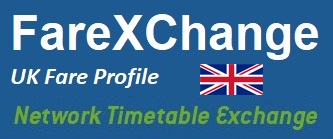
Development site
FareXChange - A Profile for exchanging UK Bus Fare data -
Overview
Examples
UK Standards
- FareXChange profile
- NeTEx UK
- UK NaPTAN (Stops)x
- UK TransXChange (Timetables)
- UK NOC (Operators)
CEN Standards
Topics
- What is the FareXChange? profile
- What sort of fare information does FareXChange cover?
- What sort of other information does FareXChange cover?
- How is data exchanged with FareXChange / NeTEx?
- How is fare data organised for exchange?
The FareXChange profile can be used to aggregate and integrate machine-readable passenger information data in order to create mobile and online passenger information applications.
What is the FareXChange profile?
NeTEx is a CEN standard ; format for exchanging many different types of transport data (for example, stops, routes and timetables, accessibility fare products and prices, etc.) between different computer systems. It can be used both for national and international data exchange.
NeTEx is a modular standard with features to support the many different business practices and data identification systems found in many different countries. To use NeTEx efficiently in a given context, a "profile""is created to specify how it will be used to meet the specific business requirements . A profile can include advice on the following;
- Which data elements should be present
- The identification systems to be used (e.g. UK NPTG, NaPTAN, NOC codes etc) for the data.
- How data should be partitioned into separate files
- The expected participants and stakeholders
- The workflows to be followed.
- Examples of schedules encoded as NeTEx XML documents.
What Sort of Information does FareXChange cover?
FareXChange focuses specifically on UK bus fare data. This includes components for the following aspects of fares:
- Fare Network
- Fare Network components: Stops, tariff zones, fare stages, etc relevant for fare structures.
- Tariffs
- Tariff structures; point-to-point, zone-to-zone, zonal, section, flat, etc (All described as "access rights"to the network)
- Time Intervals: Durations for day and season period passes (1day, 1 week, 1 month annual etc).
- Time Demand Types:Peak, off-peak and other timebands, expressed as day types
- Unit Distances for section (stage based) fares
- Unit Quantities for multi-trip carnets sold at a discount
- Products
- Fare Products for travel: Products for travel such as single and return tickets, multi-trip carnets period passes, etc.
- Fare Products for travel: Products defining indirect rights such as sales discount rights, usage based discounts, stored value, etc.
- User Types: User types eligible for different types of fare product (adult, child, student, senior, etc),
- Group Tickets: Representing minimum and maximum number of different users types allowed on certain tickets.
- Usage conditions :conditions of travel, such as whether interchanges are allowed, etc
- Commercial conditions: Conditions of sale such as exchanges, refunds, purchase windows, etc,
- Sales Packages
- Sales Packages of Fare Products:bundling one or more Fare products with media and distribution information
- Distribution:Information on the available distribution channels and fulfilment methods (including restrictions by media)
- Ticket media: paper, smartcard, mobile apps, etc
- Prices
- Fare Prices for any combination of relevant fare component
What Sort of other information does FareXChange cover?
NeTEx can be used to exchange other types of data for Passenger Information, in particular toutes and timetables. Since NeTEx fare structures reference the underlying network elements in order to define the scope of applicability of fares (zones, stops etc), FareXChange makes use of a number of other network elements, in particular stops and tariff zones owing information:
- Public Transport schedules including stops, routes, departures times / frequencies, operational notes, and map coordinates. May include
- Routes may have complex topologies such as circular routes, cloverleaf and lollipops, and complex workings such as short working and express patterns. Connections with other services can also be described
- The days on which the services run, including availability on public holidays and other exceptions.
- Information about the Operators providing the service.
- Data is versioned with management metadata allowing updates across distributed systems
How is data exchanged with FareXChange / NeTEx?
NeTEx data is encoded using tags as one or more XML documents that can be exchanged by many different communication protocols (e.g. FTP, http, SNMP), etc. It can therefore be used both for the bulk exchange of XML documents based on the Schema and for the dynamic exchange of individual data objects or groups of objects, for example as http requests using the SIRI framework
NeTEx XML serialises complex PT models (especially those conforming to the CEN Transmodel conceptual model) into a standard flat file format that can be processed cheaply and efficiently using mainstream modern computer technologies.
How is data organised for exchange?
The NeTEx schema allows related data to be partitioned flexibly between one or more files. For example, the definitions of the products might be placed in one file and the prices in another. Within a file "Version Frames" are used to group related data together in a coherent set.
The FareXChange profile gives some specific guidelines for organising uk fare data for exchange. FareXChange data frames are tagged to indicate that they contain FareXChange data.

© Crown Copyright 2018-20
Page last updated: 2020/09/16

